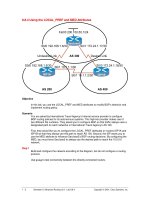The Global and Cultural Contexts pdf
Bạn đang xem bản rút gọn của tài liệu. Xem và tải ngay bản đầy đủ của tài liệu tại đây (410.74 KB, 36 trang )
NGHỆ THUẬT LÃNH ĐẠO
MSMH: NS301DV01
Chapter 2:
The Global and
Cultural Contexts
Purpose
After studying this chapter, you will be able to:
•
Understand the role culture can play in leadership
•
Describe the three levels of culture
•
Discuss the model of national culture
•
Identify the impact of gender on leadership
•
Discuss the role diversity plays in leadership
Content
Definition and levels of culture
Models of national culture
Group culture: gender and diversity
Chapter 2
2.1- Definition and
Levels of Culture
Definition and
Characteristics
•
Culture consists of the commonly held values
within a group of people. It is a set of norms,
customs, values, and assumptions that guides
the behavior of a particular group of people.
•
Culture is the lifestyle of a group the collective
programming of the group members.
•
Culture is shared by members of a group.
•
Culture has performance and is passed down
from one generation to another.
Definition and
Characteristics
•
Group members learn about their culture
through their parents and family, schools, and
other social institutions, and consciously and
unconsciously transfer it to the young and new
members.
•
Culture affects how people view the world and
how they think, and therefore, shapes behavior.
Levels of Culture
Culture exists at three levels:
•
National Culture: a set of values and beliefs shared by
people within a nation.
•
Group Culture: different cultural, ethnic, and religious
groups lead to cultural diversity (variety of human
structures, belief systems, and strategies for adopting to
situations that exist in different groups.
•
Organizational Culture: a set of values, norms and
beliefs shared by members of an organization
Impacts of Culture
•
National culture exerts a strong and pervasive influence
on people’s behavior in everyday activities and in
organizations.
•
The influence of organizational culture is, generally,
limited to work-related values and behaviors.
•
National culture strongly influences organizational culture.
•
All three levels of culture shape views and expectations of
leaders.
•
Each country and region in the world develops a particular
organizational and management style based largely on its
national culture.
Chapter 2
2.2- Models
of National
Culture
1. Hall’s High-Context and Low-
Context Cultures
•
Edward Hall’s model, divides communication styles
within cultures into two groups: high context and low
context (Hall, 1976).
• Context refers to the environment and the information
that provide the background for interaction and
communication.
–
Leaders from high-context cultures rely heavily on the context,
including nonverbal cues and situational factors, to communicate
others and understand the world around them. They use personal
relationships to establish communication.
–
Leaders from low-context cultures focus on explicit, specific
verbal and written messages to understand people and situations.
1. Hall’s High-Context and Low-
Context Cultures
2. Hofstede’s Five Cultural
Dimensions
Power distance The extent to which people accept unequal distribution
of power. In higher power-distance cultures, there is a
wider gap between the powerful and the powerless.
Uncertainty
avoidance
The extent to which the culture tolerates ambiguity and
uncertainty. High uncertainty avoidance leads to low
tolerance for uncertainty and a search for absolute truths.
Individualism The extent to which individuals or closely-knit social
structure, such as the extended family, is the basis for
social systems. Individualism leads to reliance on self
and focus on individual achievement.
Masculinity The extent to which assertiveness and independence
from others is valued. High masculinity leads to high
sex-role differentiation, focus on independence,
ambition, and material goods.
Time orientation The extent to which people focus on past, present or
future. Present orientation leads to a focus on short-term
performance.
3. Tigh and Loose Cultures
•
Harry Triandis (2004): uncertainty avoidance be
classified into tigh or loose categories.
•
In tigh cultures, members follow rules, norms, and
standards closely.
–
Behaviors are, therefore, closely regarded; those who do not
abide by the rules are criticized, isolated, or even ostracized,
depending on the severity of the offense.
•
Loose cultures show much tolerance for behaviors that
are considered acceptable, and although rules exist,
violating them is often overlooked.
4. Vertical and Horizontal
Dimensions of Individualism and
Collectivism
Vertical (emphasis on
Hierarchy)
Horizontal (emphasis on
Equality)
Individualistic Focus on the individual
where each person is
considered unique and
superior to others, often
based on accomplishments
and performance, or material
wealth. Ex: USA
Although the focus is on
each individual being unique,
individuals are considered
equal to others without a
strong hierarchy. Ex:
Sweden.
Collectivistic Strong group feeling with
clear rank and status
differentiation among group
members; members feel
obligation to obey authority
and sacrifice self for good of
the group if needed. Ex:
Japan.
All group members are
considered equal; the group
has little hierarchy and there
is strong focus on democratic
and egalitarian processes.
Ex: Israel.
5. Trompenaars’s Cross-Cultural
Organizational Cultures
•
Fons Trompenaars: cross-cultural organizational
cultures can be classified on two dimensions
(Trompenaars, 1994):
–
Egalitarian-hierarchical and
–
Orientation to the person or the task.
5. Trompenaars’s Cross-Cultural
Organizational Cultures
5. Trompenaars’s Cross-Cultural
Organizational Cultures
• Incubator Cultures are egalitarian and focus on taking
care of individual needs.
–
Leaders in such organizations emerge from the group rather than
being assigned.
–
Therefore, leadership is based on competence and expertise, and
the leader’s responsibility is to provide resources, manage
conflict, and remove obstacles.
• The Guided Missile is also egalitarian culture, but focus
on task completion rather than individual needs.
– In guided-missile organizations, leadership is based on expertise
and follower participation is expected.
– People work in teams of professionals who have equal status,
with performance being the primary criterion for effectiveness.
5. Trompenaars’s Cross-Cultural
Organizational Cultures
• The Eiffel Tower cultures is hierarchical and task
focused. It is characterized by a steep, stable,
and rigid organization.
– The focus is on performance through order and
obedience of legal and legitimate authority.
– The leader is the undisputed head of the organization
and has full responsibility for all that occurs.
•
The Family Culture is hierarchical and take care
of individuals.
–
The family culture functions like a traditional family.
–
The leader’s role is that of a powerful father figure, who
is responsible for the welfare of all members.
6. Global Leadership and
Organizational Behavior
Effectiveness Research (GLOBE)
• Conducted by a group of researchers in 62 countries
(House et al., 2004)
•
GLOBE examines culture using 9 dimensions.
•
GLOBE assumes that culture affects what leaders do and
how organizations are structured and managed.
•
GLOBE identifies several categories of leader behavior:
–
Charismatic/ value-based leadership is generally desirable
across most cultures.
–
Team-based leadership is believed to contribute to outstanding
leadership in many cultures.
–
Participative leadership is seen, generally, as positive, its
effectiveness depends on the culture.
–
Autonomous leaders are desirable in some cultures but not in
all.
–
Self-protective leadership is seen as impeding effective
leadership in most cultures.
6. Global Leadership and
Organizational Behavior
Effectiveness Research (GLOBE)
Dimension Description
Power distance The degree to which power is distributed equally.
Uncertainty
avoidance
The extent to which a culture relies on social norms and rules to
reduce unpredictability (high score indicates high tolerance for
uncertainty)
Human
orientation
The degree to which a culture values fairness, generosity, caring
and kindness.
Collectivism I
(institutional)
The degree to which a culture values and practices collective
distribution of resources.
Collectivism II
(in-group)
The degree to which individuals express pride and cohesion in
their family or organization.
Assertiveness The degree to which individuals are assertive, direct and
confrontational.
Gender
egalitarianism
The extent of gender differentiation (high score indicates more
differentiation)
Future
orientation
The extent to which a culture invests in the future rather than in
the present or past.
Performance
orientation
The degree to which a culture values and encourages performance
and excellence.
Chapter 2
2.3- Group Culture
Group Culture
•
Group culture may consist of a number of
–
primary factors such as gender, ethnicity, and age
and other
–
secondary factors such as income, education, and
membership in various groups.
Dimensions of Group
Culture and Diversity









